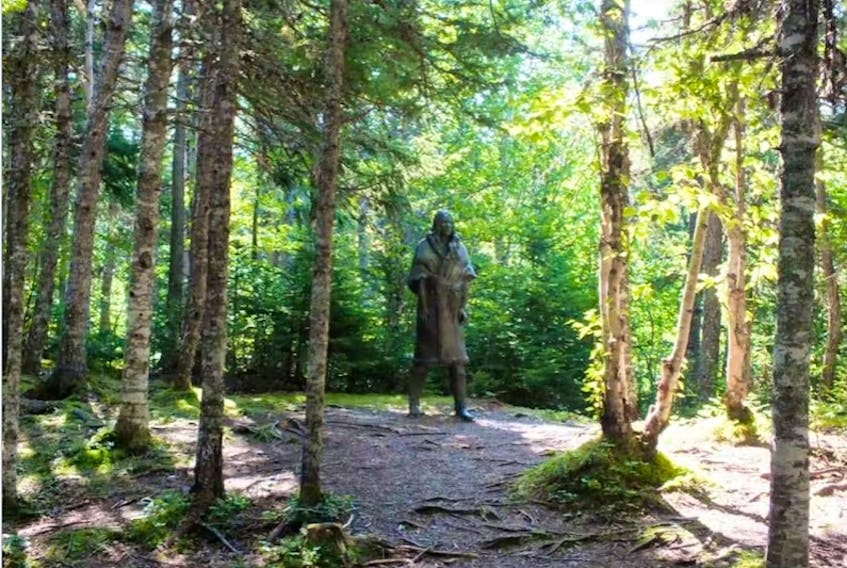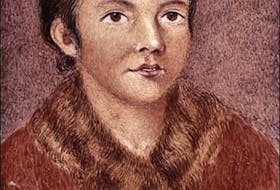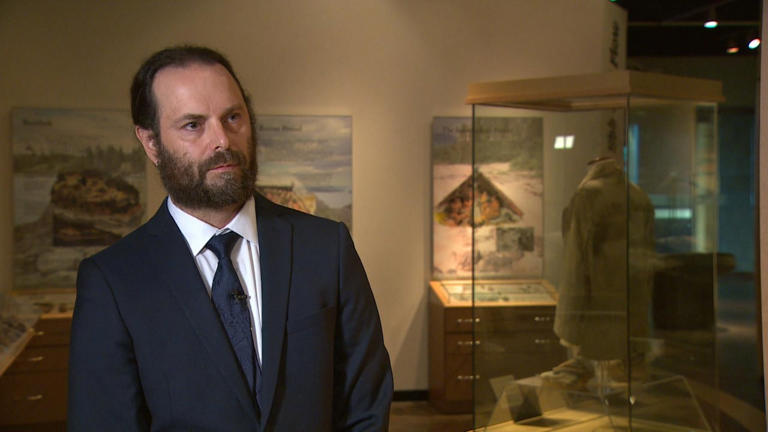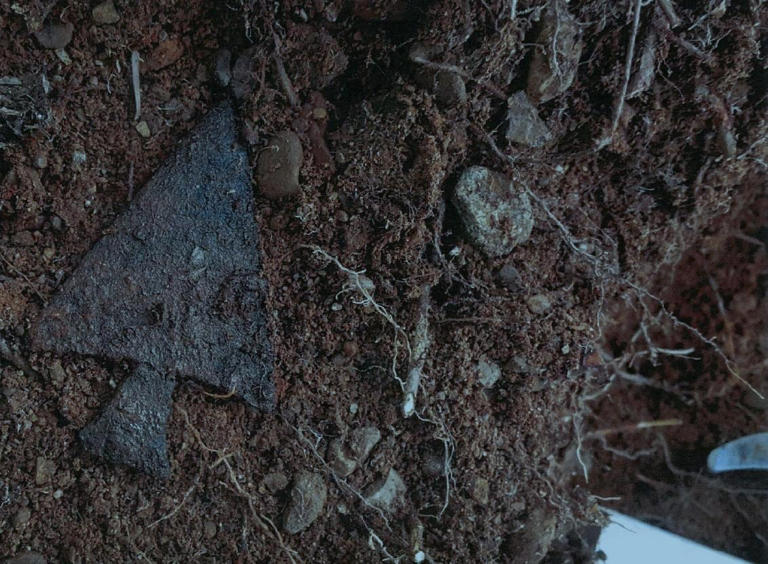Reinventing the Beothuk narrative: how genetics has raised thorny issues of history, culture and Indigenous identity
Re-examining relationship with Mi’kmaq peoples
Peter Jackson · Local Journalism Initiative Reporter | Posted: a day ago | Updated: a day ago | 8 Min Read

Gerald Squires’ statue "The Spirit of the Beothuk" stands among the trees overlooking the place where the Beothuks lived hundreds of years ago in Boyd’s Cove, - Contributed
One hundred years ago, American anthropologist Frank Speck wrote about his encounter with a Mi’kmaq family who had set up camp near Gloucester, Mass.
Joe Toney, there with his wife, child and mother, told Speck they were originally from Newfoundland. Then he said his late father, Kop, had been a member of the Osa'yan'a tribe at Red Pond. Speck realized it was the Mi’kmaq term for Beothuk, and that Red Pond was Red Indian Lake (since renamed Beothuk Lake).
The American spoke to Joe’s mother, Santu, at length while Joe translated. She said her husband remembered being stained with red ochre as a child, but that the Mi’kmaw had taken him while he was young and converted him to Christianity. She even sang a song, though it's authenticity is uncertain.
When Speck brought the story to geologist James P. Howley — who, at the time, was the foremost authority on the Beothuk — the latter expressed doubts.
“Notwithstanding the fact that Mr. Howley's opinions, based on his extensive knowledge of Newfoundland history and physiography, deserve serious consideration,” Soeck wrote in his 1922 book “Beothuk and Micmac,” “I hardly think, under the circumstances, that the conclusions of one trained in sciences other than ethnology are sufficient to warrant absolutely casting aside information which may be of value, and which on the face of it does bear some semblance of truthfulness.”
Speck was likely the first scholar to document the possibility of Beothuk blood still coursing through the veins of living descendants.
Almost 100 years later, Ryerson film professor Chris Aylward raised the bar again with his hour-long documentary “The Beothuk Story,” which included interviews with Ivy Toney and Ardy Landry, Santu’s granddaughter and great-granddaughter living in Nova Scotia.
Landry has since died.
One hundred years ago, American anthropologist Frank Speck wrote about his encounter with a Mi’kmaq family who had set up camp near Gloucester, Mass.
Joe Toney, there with his wife, child and mother, told Speck they were originally from Newfoundland. Then he said his late father, Kop, had been a member of the Osa'yan'a tribe at Red Pond. Speck realized it was the Mi’kmaq term for Beothuk, and that Red Pond was Red Indian Lake (since renamed Beothuk Lake).
The American spoke to Joe’s mother, Santu, at length while Joe translated. She said her husband remembered being stained with red ochre as a child, but that the Mi’kmaw had taken him while he was young and converted him to Christianity. She even sang a song, though it's authenticity is uncertain.
When Speck brought the story to geologist James P. Howley — who, at the time, was the foremost authority on the Beothuk — the latter expressed doubts.
“Notwithstanding the fact that Mr. Howley's opinions, based on his extensive knowledge of Newfoundland history and physiography, deserve serious consideration,” Soeck wrote in his 1922 book “Beothuk and Micmac,” “I hardly think, under the circumstances, that the conclusions of one trained in sciences other than ethnology are sufficient to warrant absolutely casting aside information which may be of value, and which on the face of it does bear some semblance of truthfulness.”
Speck was likely the first scholar to document the possibility of Beothuk blood still coursing through the veins of living descendants.
Almost 100 years later, Ryerson film professor Chris Aylward raised the bar again with his hour-long documentary “The Beothuk Story,” which included interviews with Ivy Toney and Ardy Landry, Santu’s granddaughter and great-granddaughter living in Nova Scotia.
Landry has since died.
War of words
When Aylward’s documentary first aired on NTV in 2021, it created a stir and evoked some criticism.
Ingeborg Marshall, whose 1996 tome “A History and Ethnography of the Beothuk” has been generally accepted as the most authoritative exploration of the tribe, publicly took issue with its premise that Beothuk people still live among us.
“Despite the extensive claims of possible survival of Beothuk genetic material into modern times, the lesson which the documentary failed to present is the fact that the Beothuk culture is extinct and therefore the Beothuk, as an independent ‘ethnic group,’ are considered to have died out,” she wrote in a letter to The Telegram.

Christopher Aylward is a film professor at the Ryerson School of Journalism.
- Keith Gosse
Aylward replied to Marshall’s letter in kind.
“I was both saddened and perplexed by Marshall’s letter: saddened for the misunderstanding and hurt its opinion has caused among the island’s Beothuk and Mi’kmaq peoples,” he wrote, “and perplexed that such an outdated and misinformed opinion continues to find a voice.”
Reached by phone recently on the north coast of Newfoundland, Aylward was less dismissive of Marshall’s take.
“If you’re trying to get at the truth of history, if such a thing even exists, it makes more sense … to take into account all of the pieces and try to find as many as you can and pay attention to them,” he said.
“I believe you fall into a trap when you believe any one source.”
But he persists in referring to the people he talked to as “Beothuk,” and says the written record of Europeans such as William Cormack and the Peyton family are given too much weight.
“Some academics are very threatened by another voice and are very much in opposition to it. And I would definitely put Ingeborg among those people,” he said.
“If you’re trying to get at the truth of history, if such a thing even exists, it makes more sense … to take into account all of the pieces and try to find as many as you can and pay attention to them."
— Christopher Aylward
Lost culture
At 93, Ingeborg Marshall now lives in a seniors apartment in St. John’s, but the veteran anthropologist is still very much active with Beothuk research.
During an interview, she frequently gets up to consult letters and excerpts from books, some of which challenge her arguments and others that back them.
She says there’s nothing in her research that has been disproven as such, and stands by the central narrative that the last known Beothuk, Shanawdithit, died in St. John’s in 1829 and that her tribe, as a distinct cultural entity, has vanished.

Aylward replied to Marshall’s letter in kind.
“I was both saddened and perplexed by Marshall’s letter: saddened for the misunderstanding and hurt its opinion has caused among the island’s Beothuk and Mi’kmaq peoples,” he wrote, “and perplexed that such an outdated and misinformed opinion continues to find a voice.”
Reached by phone recently on the north coast of Newfoundland, Aylward was less dismissive of Marshall’s take.
“If you’re trying to get at the truth of history, if such a thing even exists, it makes more sense … to take into account all of the pieces and try to find as many as you can and pay attention to them,” he said.
“I believe you fall into a trap when you believe any one source.”
But he persists in referring to the people he talked to as “Beothuk,” and says the written record of Europeans such as William Cormack and the Peyton family are given too much weight.
“Some academics are very threatened by another voice and are very much in opposition to it. And I would definitely put Ingeborg among those people,” he said.
“If you’re trying to get at the truth of history, if such a thing even exists, it makes more sense … to take into account all of the pieces and try to find as many as you can and pay attention to them."
— Christopher Aylward
Lost culture
At 93, Ingeborg Marshall now lives in a seniors apartment in St. John’s, but the veteran anthropologist is still very much active with Beothuk research.
During an interview, she frequently gets up to consult letters and excerpts from books, some of which challenge her arguments and others that back them.
She says there’s nothing in her research that has been disproven as such, and stands by the central narrative that the last known Beothuk, Shanawdithit, died in St. John’s in 1829 and that her tribe, as a distinct cultural entity, has vanished.

Ingeborg Marshall is the author of "A History and Ethnography of the Beothuk."
- Peter Jackson
The disagreement appears to be one of semantics. Scientists have discovered traces of many lost cultures and races in living people, Marshall says, including strands of Neanderthal DNA.
There is some discussion of genetics in Aylward's film, including an interview with Memorial University biologist Steve Carr, who has been hired by Miawpukek First Nations in Conne River to compare known DNA from Beothuk remains with its Mi’kmaw members.
Miawpukek’s Chief Mi’sel Joe says Carr has already found Beothuk markers in two living residents, but adds the study is in only a preliminary stage.
None of that matters anyway, says Marshall. She agrees it’s plausible the Beothuk may have intermarried with other tribes and with Europeans, but the lineage decreases over time.
“Every time they remarry, it’s only half,” she says. “After five or six or seven generations, you (approach) one per cent.”
For Joe, the question is not so much whether Beothuk people are still alive today, it’s more about re-examining the relationship between the Mi’kmaq and the Beothuk through the lens of oral history as well as documented encounters.

The disagreement appears to be one of semantics. Scientists have discovered traces of many lost cultures and races in living people, Marshall says, including strands of Neanderthal DNA.
There is some discussion of genetics in Aylward's film, including an interview with Memorial University biologist Steve Carr, who has been hired by Miawpukek First Nations in Conne River to compare known DNA from Beothuk remains with its Mi’kmaw members.
Miawpukek’s Chief Mi’sel Joe says Carr has already found Beothuk markers in two living residents, but adds the study is in only a preliminary stage.
None of that matters anyway, says Marshall. She agrees it’s plausible the Beothuk may have intermarried with other tribes and with Europeans, but the lineage decreases over time.
“Every time they remarry, it’s only half,” she says. “After five or six or seven generations, you (approach) one per cent.”
For Joe, the question is not so much whether Beothuk people are still alive today, it’s more about re-examining the relationship between the Mi’kmaq and the Beothuk through the lens of oral history as well as documented encounters.

Mi'sel Joe is chief of the Miawpukek First Nation at Conne River.
- Peter Jackson
One of the primary sources suggesting a hostile relationship between the two tribes comes from Shanawdithit herself, as recorded by her captors.
Joe says there would have been periods of both hostility and peace between the two groups.
“If you look at the world today, the fighting that goes on in what you call the holy wars, and back then you got to keep in mind, over 200 years ago, if you found someone on your hunting ground, of course there was going to be a fight,” he said. “It went both ways.”
But he insists the Mi’kmaq’s role in the Beothuk demise has been overstated.
“Our people knew and lived with Beothuk people, and there was intermarriage between the two,” he says.
Read Part 2 of this two-part series in Tuesday's edition of The Telegram.
One of the primary sources suggesting a hostile relationship between the two tribes comes from Shanawdithit herself, as recorded by her captors.
Joe says there would have been periods of both hostility and peace between the two groups.
“If you look at the world today, the fighting that goes on in what you call the holy wars, and back then you got to keep in mind, over 200 years ago, if you found someone on your hunting ground, of course there was going to be a fight,” he said. “It went both ways.”
But he insists the Mi’kmaq’s role in the Beothuk demise has been overstated.
“Our people knew and lived with Beothuk people, and there was intermarriage between the two,” he says.
Read Part 2 of this two-part series in Tuesday's edition of The Telegram.
Related Stories

LETTER: Saddened and perplexed by outdated and misinformed opinions on Beothuk and Mi’kmaq peoples
UPDATED FEB. 17, 2022

LETTER: Documentary suggests Beothuk may not be extinct — but they are
UPDATED DEC. 11, 2021

Medium matters: Ryerson professor assembling pieces of the Beothuk story in documentary
UPDATED MAY. 18, 2021

LETTER: Saddened and perplexed by outdated and misinformed opinions on Beothuk and Mi’kmaq peoples
UPDATED FEB. 17, 2022

LETTER: Documentary suggests Beothuk may not be extinct — but they are
UPDATED DEC. 11, 2021

Medium matters: Ryerson professor assembling pieces of the Beothuk story in documentary
UPDATED MAY. 18, 2021






